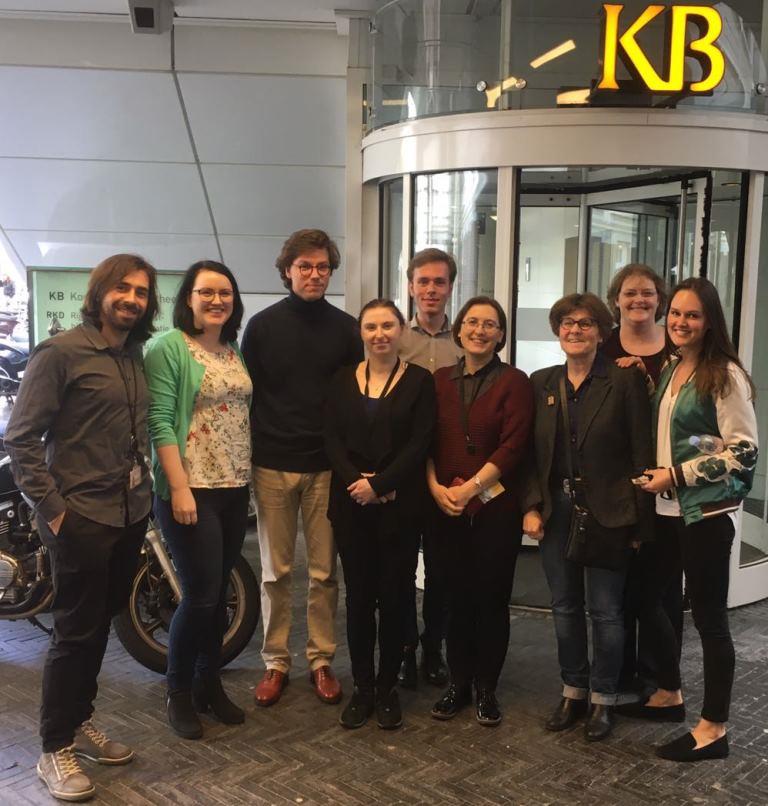CERL Grant 2016/17
CERL Internship and Placement Grant 2016/17 – The Hague, Koninklijke Bibliotheek, 1-31 May 2017
The CERL Internship and Placement Grant 2016/17 allowed us to work at the Koninklijke Bibliotheek from 1 May to 31 May 2017, as Marieke van Delft, Curator of the Early Printed Books Department, decided to start a project for the cataloguing of incunables in the database Material Evidence of Incunabula.
The work, which involved (and involves) Dr van Delft, the three of us and three Dutch university interns, did not start from scratch: former Curator Gerard van Thienen already made many researches on the incunabula kept by the KB, focusing above all on watermarks (which for Dutch books are all inserted in WILC, book collation and provenance evidences.
Van Thienen’s researches merged in file cards, where the main copy features related to different provenances (inscriptions, ex-libris, stamps, binding, bibliographic references, especially to auction catalogues, etc…) are shortly described. All this information was also transferred to the internal catalogue of the KB and finally to the OPAC. Also, van Thienen produced sizeable dossiers for each incunable of the collection: all of this, along with the ISTC description of the edition, was our starting point.
The KB incunables were inserted in MEI shortly before the beginning of the project, by linking the exemplars to the ISTC record (edition features) and by retrieving data from the library OPAC (copy features). Those data needed to be checked book-in-hand, translated in English, structured in the proper MEI editing fields and sometimes updated with further researches.
For this, Dr van Delft introduced us to the specific resources that we could use: the card catalogues of Van Thienen, the bibliographies of incunabula printed in the Low Countries (Campbell and Incunabula printed in the Low Countries), auction catalogues of former owners, the accessions registers of the KB, the incunabula dossiers, copies of former owners from various other catalogues with provenance records.
Before starting the research for MEI, it was necessary to insert all the main former owners in the external database Owners of Incunabula: some of them had already been identified and inserted by other libraries involved in MEI, but for some others (especially those known only for a brief inscription in the book) it was necessary to spend some time looking for further information.
It took a while to become acquainted with the database (our thanks go to Geri de la Rocca for his training) and to insert the authority records in OoI; furthermore, as each CERL intern came from a different ‘academic background’ (which was also different from the Dutch), together with Dr van Delft we needed to establish some basic guidelines both for the technical lexicon to use and the depth to reach in our researches. Furthermore we decided to make pictures of key pages for KB’s OPAC and MEI.
Thus, except for a few books described in the first days, proper cataloguing on MEI started only in the second week at the KB. During our internship the three of us updated some 120 incunabula (Ruben Celani and Maria O’Shea) and 110 former owners (Judit Kolumban). The more we became acquainted with the database, the more incunabula we could proceed on in a day.
Even though most of the job has still to be done, the main features of the collection are already emerging, such as the importance of former owners as Jacob Visser, or the number of books at the KB that were for a while in the collection of Pietro Antonio Bolongaro Crevenna, before Joost Romswinckel acquired and finally sold them to the KB. In those cases it is possible to reproduce the library (or at least, a good part of it) of these book collectors. In other cases the single copy shows so many different examplees of provenance evidence that, with a bit of research (and a lot of luck), it’s possible to follow the journeys that it took since it was printed. And this is probably the most fascinating chance that a database like MEI can give us.
About the organisation of this internship the following. Besides the three of us, two interns from Dutch universities worked for MEI, so we had a pleasant group of people with various expertise that could help each other. Dr van Delft guided us with the work on the incunabula, Ed van der Vlist, Curator of Medieval Manuscripts helped us with paleographical questions and the people from the stacks and the loan desk were very helpful bringing and lending the incunabula. Most of the time we worked at the Reading Room of the Department of Special Collections; outside opening times we were hosted in the office of the curator. Besides working at the KB we visited the exhibition Conn3ct at the Museum Meermanno / House of the Book and were shown around in The Hague. The whole group of interns visited the Department of Special Collections in Amsterdam. In our last week we gave a presentation of our work and the results to colleagues of the KB. This presentation was greatly appreciated.
Through this internship we became acquainted with MEI. Furthermore we expanded our knowledge on incunabula and their provenances and which sources can be used for provenance research. More specific we learned about Dutch incunabula and their collectors, and about libraries and Special Collections in the Netherlands. And of course we experienced working in a National Library in a foreign country.
Ruben Celani, Judit Kolumban and Maria O’Shea
